Truncated trioctagonal tiling
| Truncated trioctagonal tiling | |
|---|---|
 Poincaré disk model of the hyperbolic plane | |
| Type | Hyperbolic uniform tiling |
| Vertex configuration | 4.6.16 |
| Schläfli symbol | tr{8,3} or |
| Wythoff symbol | 2 8 3 | |
| Coxeter diagram | |
| Symmetry group | [8,3], (*832) |
| Dual | Order 3-8 kisrhombille
|
| Properties | Vertex-transitive
|
In
of tr{8,3}.Symmetry

The dual of this tiling, the order 3-8 kisrhombille, represents the fundamental domains of [8,3] (*832) symmetry. There are 3 small index subgroups constructed from [8,3] by mirror removal and alternation. In these images fundamental domains are alternately colored black and white, and mirrors exist on the boundaries between colors.
A larger index 6 subgroup constructed as [8,3*], becomes [(4,4,4)], (*444). An intermediate index 3 subgroup is constructed as [8,3⅄], with 2/3 of blue mirrors removed.
Index
|
1 | 2 | 3 | 6 | |
|---|---|---|---|---|---|
| Diagrams | 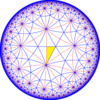
|
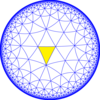
|
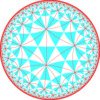
|
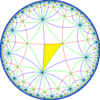
|
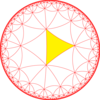
|
| Coxeter (orbifold) |
[8,3] = (*832) |
[1+,8,3] = ( *433 )
|
[8,3+] = (3*4) |
[8,3⅄] = ( *842 )
|
[8,3*] = ( *444 )
|
| Direct subgroups | |||||
| Index | 2 | 4 | 6 | 12 | |
| Diagrams | 
|
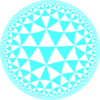
|
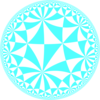
|
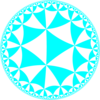
| |
| Coxeter (orbifold) |
[8,3]+ = (832) |
[8,3+]+ = (433) |
[8,3⅄]+ = (842) |
[8,3*]+ = (444) | |
Order 3-8 kisrhombille
| Truncated trioctagonal tiling | |
|---|---|
face-transitive |
The order 3-8 kisrhombille is a
The image shows a Poincaré disk model projection of the hyperbolic plane.
It is labeled V4.6.16 because each right triangle face has three types of vertices: one with 4 triangles, one with 6 triangles, and one with 16 triangles. It is the
Naming
An alternative name is 3-8 kisrhombille by
Related polyhedra and tilings
This tiling is one of 10 uniform tilings constructed from [8,3] hyperbolic symmetry and three subsymmetries [1+,8,3], [8,3+] and [8,3]+.
| Uniform octagonal/triangular tilings | |||||||||||||
|---|---|---|---|---|---|---|---|---|---|---|---|---|---|
| Symmetry: [8,3], (*832)
|
[8,3]+ (832) |
[1+,8,3] (*443) |
[8,3+] (3*4) | ||||||||||
| {8,3} | t{8,3} | r{8,3} | t{3,8} | {3,8} | rr{8,3} s2{3,8} |
tr{8,3} | sr{8,3} | h{8,3} | h2{8,3} | s{3,8} | |||
| Uniform duals | |||||||||||||
| V83 | V3.16.16 | V3.8.3.8 | V6.6.8 | V38 | V3.4.8.4 | V4.6.16
|
V34.8 | V(3.4)3 | V8.6.6 | V35.4 | |||
This tiling can be considered a member of a sequence of uniform patterns with vertex figure (4.6.2p) and
| *n32 symmetry mutation of omnitruncated tilings: 4.6.2n | ||||||||||||
|---|---|---|---|---|---|---|---|---|---|---|---|---|
| Sym. *n32 [n,3] |
Spherical | Euclid. | Compact hyperb. | Paraco. | Noncompact hyperbolic | |||||||
| *232 [2,3] |
*332 [3,3] |
*432 [4,3] |
*532 [5,3] |
*632 [6,3] |
*732 [7,3] |
*832 [8,3] |
*∞32 [∞,3] |
[12i,3] |
[9i,3] |
[6i,3] |
[3i,3] | |
| Figures | 
|

|

|

|

|

|

|

|

|

|

| |
| Config. | 4.6.4 | 4.6.6 | 4.6.8 | 4.6.10 | 4.6.12 | 4.6.14 | 4.6.16 | 4.6.∞ | 4.6.24i | 4.6.18i | 4.6.12i | 4.6.6i |
| Duals | 
|

|

|

|

|

|

|

|

|

|

|

|
Config.
|
V4.6.4 | V4.6.6 | V4.6.8 | V4.6.10 | V4.6.12
|
V4.6.14
|
V4.6.16
|
V4.6.∞ | V4.6.24i | V4.6.18i | V4.6.12i | V4.6.6i |
See also
- Tilings of regular polygons
- Hexakis triangular tiling
- List of uniform tilings
- Uniform tilings in hyperbolic plane
References
- ISBN 978-1-56881-220-5(Chapter 19, The Hyperbolic Archimedean Tessellations)
- "Chapter 10: Regular honeycombs in hyperbolic space". The Beauty of Geometry: Twelve Essays. Dover Publications. 1999. LCCN 99035678.



